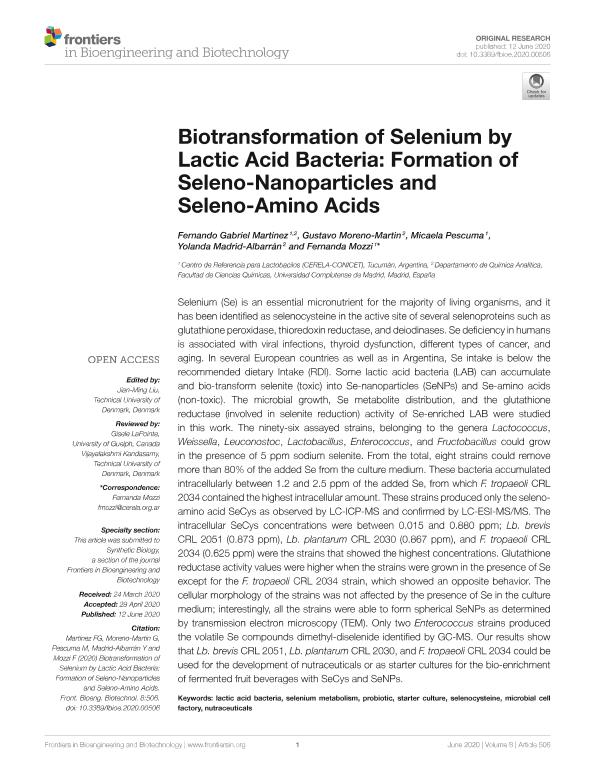Artículo
Biotransformation of Selenium by Lactic Acid Bacteria: Formation of Seleno-Nanoparticles and Seleno-Amino Acids
Martínez, Fernando Gabriel ; Moreno Martin, Gustavo; Pescuma, Micaela
; Moreno Martin, Gustavo; Pescuma, Micaela ; Madrid Albarrán, Yolanda; Mozzi, Fernanda Beatriz
; Madrid Albarrán, Yolanda; Mozzi, Fernanda Beatriz
 ; Moreno Martin, Gustavo; Pescuma, Micaela
; Moreno Martin, Gustavo; Pescuma, Micaela ; Madrid Albarrán, Yolanda; Mozzi, Fernanda Beatriz
; Madrid Albarrán, Yolanda; Mozzi, Fernanda Beatriz
Fecha de publicación:
06/2020
Editorial:
Frontiers Media S.A.
Revista:
Frontiers in Bioengineering and Biotechnology
e-ISSN:
2296-4185
Idioma:
Inglés
Tipo de recurso:
Artículo publicado
Clasificación temática:
Resumen
Selenium (Se) is an essential micronutrient for the majority of living organisms, and it has been identified as selenocysteine in the active site of several selenoproteins such as glutathione peroxidase, thioredoxin reductase, and deiodinases. Se deficiency in humans is associated with viral infections, thyroid dysfunction, different types of cancer, and aging. In several European countries as well as in Argentina, Se intake is below the recommended dietary Intake (RDI). Some lactic acid bacteria (LAB) can accumulate and bio-transform selenite (toxic) into Se-nanoparticles (SeNPs) and Se-amino acids (non-toxic). The microbial growth, Se metabolite distribution, and the glutathione reductase (involved in selenite reduction) activity of Se-enriched LAB were studied in this work. The ninety-six assayed strains, belonging to the genera Lactococcus, Weissella, Leuconostoc, Lactobacillus, Enterococcus, and Fructobacillus could grow in the presence of 5 ppm sodium selenite. From the total, eight strains could remove more than 80% of the added Se from the culture medium. These bacteria accumulated intracellularly between 1.2 and 2.5 ppm of the added Se, from which F. tropaeoli CRL 2034 contained the highest intracellular amount. These strains produced only the seleno-amino acid SeCys as observed by LC-ICP-MS and confirmed by LC-ESI-MS/MS. The intracellular SeCys concentrations were between 0.015 and 0.880 ppm; Lb. brevis CRL 2051 (0.873 ppm), Lb. plantarum CRL 2030 (0.867 ppm), and F. tropaeoli CRL 2034 (0.625 ppm) were the strains that showed the highest concentrations. Glutathione reductase activity values were higher when the strains were grown in the presence of Se except for the F. tropaeoli CRL 2034 strain, which showed an opposite behavior. The cellular morphology of the strains was not affected by the presence of Se in the culture medium; interestingly, all the strains were able to form spherical SeNPs as determined by transmission electron microscopy (TEM). Only two Enterococcus strains produced the volatile Se compounds dimethyl-diselenide identified by GC-MS. Our results show that Lb. brevis CRL 2051, Lb. plantarum CRL 2030, and F. tropaeoli CRL 2034 could be used for the development of nutraceuticals or as starter cultures for the bio-enrichment of fermented fruit beverages with SeCys and SeNPs.
Archivos asociados
Licencia
Identificadores
Colecciones
Articulos(CERELA)
Articulos de CENTRO DE REFERENCIA PARA LACTOBACILOS (I)
Articulos de CENTRO DE REFERENCIA PARA LACTOBACILOS (I)
Articulos(SEDE CENTRAL)
Articulos de SEDE CENTRAL
Articulos de SEDE CENTRAL
Citación
Martínez, Fernando Gabriel; Moreno Martin, Gustavo; Pescuma, Micaela; Madrid Albarrán, Yolanda; Mozzi, Fernanda Beatriz; Biotransformation of Selenium by Lactic Acid Bacteria: Formation of Seleno-Nanoparticles and Seleno-Amino Acids; Frontiers Media S.A.; Frontiers in Bioengineering and Biotechnology; 8; 6-2020; 1-17
Compartir
Altmétricas



